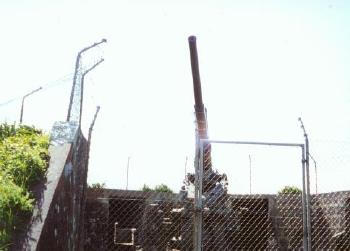Terceira, The Azores (Açores), Portugal (March 2001)

Monte Brasil is an odd appendage hanging off of Terceira’s south central coast (map). It forms a bay and a natural harbor with its teardrop shape. Additionally it deflects prevailing winds that come from the west and the southwest.
Its heights allowed defensive positions that protected the land below from foreign enemies. Additionally this fortunate geography provided optimal settlement opportunities. Thus it’s no surprise that Angra do Heroísmo formed here early in the history of Azores settlement. This photograph comes from one of Monte Brasil’s scenic overlooks, with Angra do Heroísmo appearing in the background.
Inside the Volcano

As is common in the Azores, Monte Brasil was born of fire. A volcano spewed magma and created a mound that eventually grew out of the sea. Then it adhered to Terceira, only to collapse upon itself.
From a distance this mountain looks as if it forms a solid mound. However, once over the summit the truth reveals a hollow bowl, the caldera of an extinct volcano. Today this is a nature preserve and a protected place for increasingly threatened native plant species.
In More Recent Times

Monte Brasil’s strategic military position did not end with the decline of colonialism. The Azores remained an important resting, refueling and reconnoitering point for ships, airplanes and troops.
This World War II antiaircraft battery was placed atop the mountain to ward off possible enemy bombardment of the town below. Afterward the War, the United States Air Force continued to maintain a localized presence. Portuguese and American fighter jets could been seen and heard screaming across the island of Terceira during our visit.

Leave a Reply